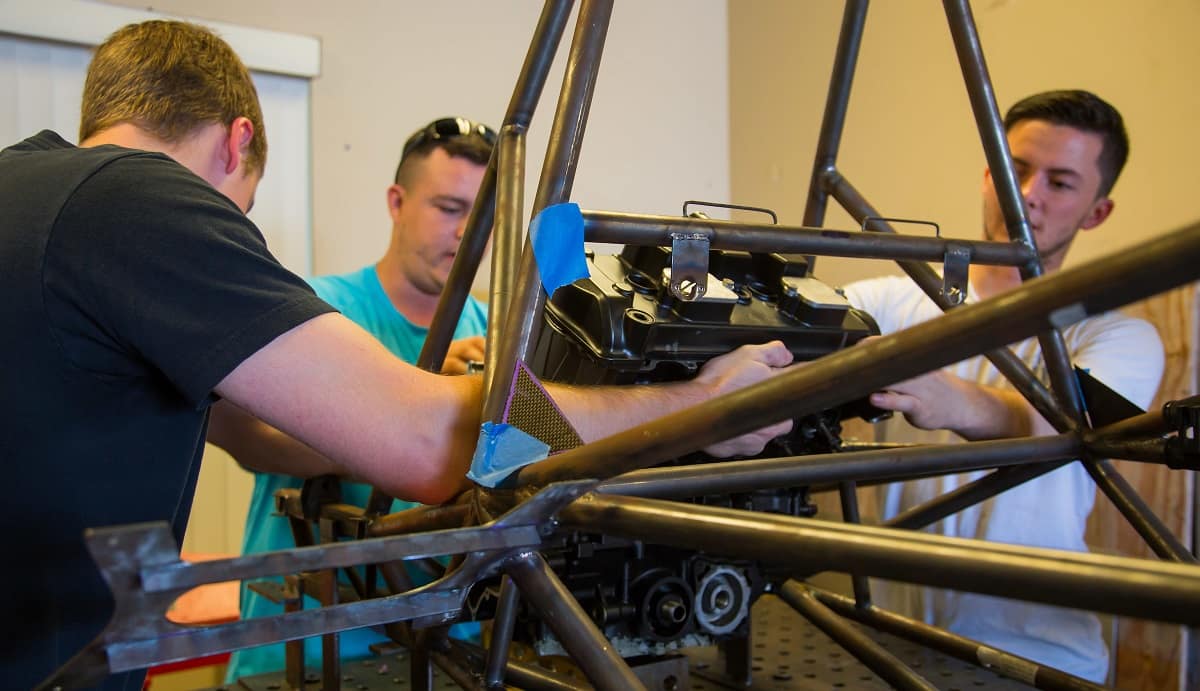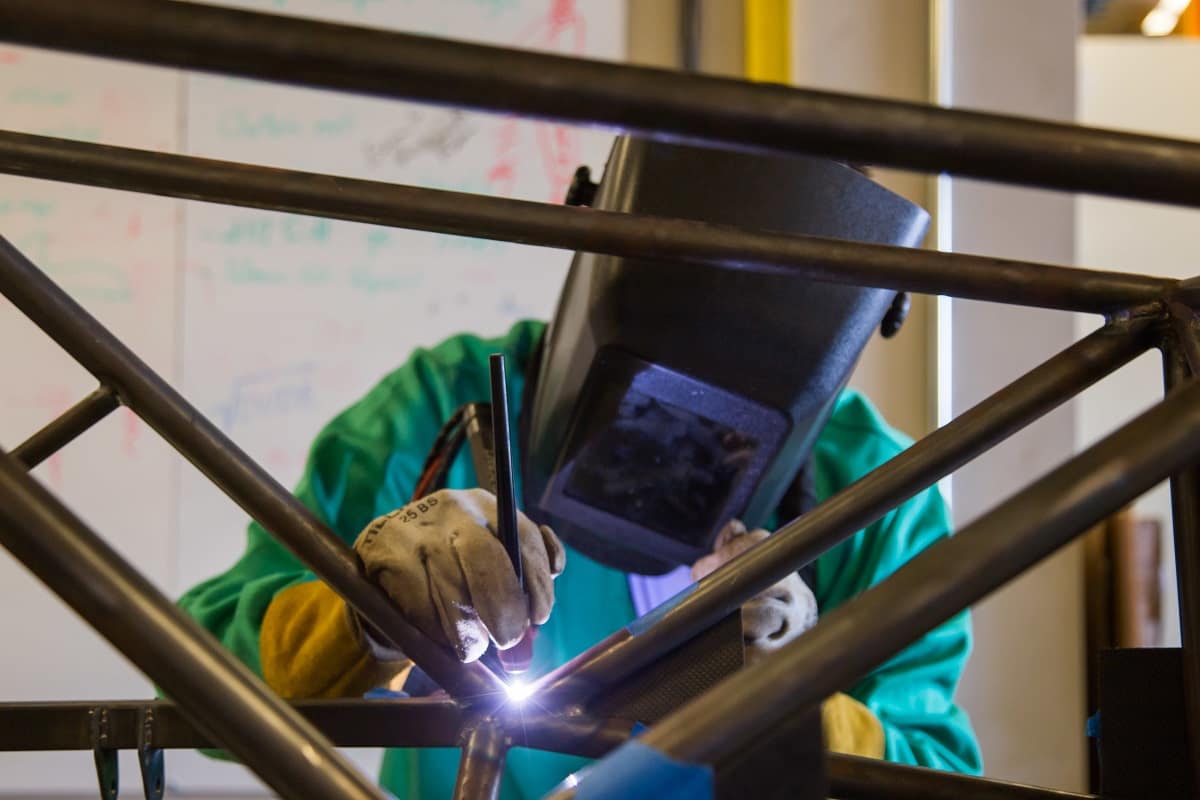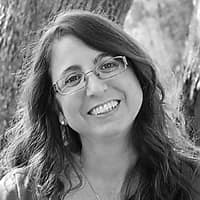Students Build Race Car for International Competition

Several Embry-Riddle Aeronautical University mechanical engineering students surround the chassis of a small Formula-style race car they have designed and are building from the ground up in just nine months.
Trevor Duffy works on the air intake system that brings air into the engine while Jose Rodriguez helps build the firewall panel between the engine and the cockpit that protects the driver. Jack Liggins, meanwhile, is welding part of the frame.
Inside the computer lab, senior Maxwell Kline, team lead and one of the drivers for the Formula SAE (Society of Automotive Engineers) series competition, is handed part of the pedal assembly that he previously designed using 3D CAD (computer-aided design) software.
“This is my favorite part,” said Kline, who is also president of the ERAU Motorsports Club on the Daytona Beach Campus. “You see it go from a piece of paper to a digital workspace where you design and do all your simulations and then to the physical world.”
The Embry-Riddle team is gearing up for the Formula SAE competition in May at the Michigan International Speedway against 120 teams from around the world. About 40 Embry-Riddle students, including undergraduate and graduate students, are building an open-wheel style high-performance vehicle in nine months, including designing, constructing, testing and even racing the car competitively.
Every aspect of the car is designed and manufactured by the students except the engine, a Honda 600 cc liquid-cooled inline four-cylinder engine.
Not only do the students assemble and race the car, the international competition also requires they provide a detailed business plan and cost analysis based on a 1,000-unit production run. Some other awards are based on fuel efficiency, innovative use of technology, endurance, acceleration, analytical approach to design and overall dynamic performance.
David Spitzer, staff research engineer for Embry-Riddle’s Center for Motorsports Engineering, said the Formula SAE is well known throughout the engineering industry. Spitzer competed in Formula SAE when he was an engineering student at Cornell University in the early 1990s and went on to a long career in professional auto racing before coming to Embry-Riddle in 2014. He said the competition helps students when they apply for internships and jobs because it demonstrates that they’ve faced a challenge and had to rely on their teammates.

“In the classroom setting, assignments are neat and tidy. Questions are simplified and an easy solution can be found,” Spitzer said. “But in the real world, it’s not like that. It’s really complex. One of the skills an engineer must learn is how to think things through and look at all aspects of a problem, such as strength, heat, friction, dimensional tolerance, and material choice. Often, they have to make their own assumptions to find a solution.”
This year, parts of the car such as the firewall are being made with a lighter carbon fiber material that may enhance the vehicle’s speed and efficiency. Improvements are also being made in the composite design, fabrication process, powertrain and braking systems.
Rafael Rodriguez, assistant professor of mechanical engineering and co-advisor for the team, said this competition is the closest experience to a real engineering job in that students see a product go from design to assembly. “It is very fast paced,” Rodriguez said. “They are making decisions based on good engineering judgment. This is the type of experience companies are looking for.”
While some graduates go on to work in the motorsports field, many are working throughout the engineering and aerospace fields.
Alexander Hurd, for example, graduated in December 2016 with a bachelor’s degree in mechanical engineering. He’s now a manufacturing engineer with machine tool builder Haas Automation in Oxnard, Calif. He not only designs custom tools and tooling for the assemblers on the shop floor, but is responsible for maintaining work instructions, sustaining/troubleshooting on the assembly lines and also making process/design improvements to assembly processes and products.
“The Formula team simply showed me how multitalented and dedicated you need to be in order to be a successful, cutting-edge engineer,” Hurd said.
Embry-Riddle alumnus Bill Wanstall, an IndyCar support engineer for Pratt & Miller Engineering, said the Formula competitions exposed him to multiple facets of engineering and was a great introduction to the fast-paced motorsports industry. He currently works with A.J. Foyt Racing providing software support and expertise of tools developed by Pratt & Miller, vehicle dynamics evaluation and simulation, development of data analysis methods, and ensuring the optimal performance of the vehicles.
“The tools required, analysis techniques used, and tight time and budget constraints make the competition a perfect stepping stone for those looking for the experience necessary to break into the world of motor racing,” said Wanstall, who has a bachelor’s degree in mechanical engineering and hopes to complete his master’s degree from Embry-Riddle in May.
Kline, who has participated in the competition for four years, hopes to work in motorsports designing race cars. He has a summer internship after graduation with an automotive company that manufactures race cars and then will return to Embry-Riddle for a master’s degree in mechanical engineering.
Kline is also one of four drivers in the competition. While the car goes about 75 miles per hour, it also accelerates in three seconds from zero to 60 miles per hour. “You are always pushing the car to its limits,” he said.
A senior mechanical engineering major with a concentration in high-performance vehicles, Kyle Morris worked on the suspension last year and is the lead for the suspension this year. His work on the Formula SAE team has helped him with upcoming job interviews in the automotive industry.
“It’s such an amazing thing knowing how much blood, sweat and tears goes into building the car [for the competition] and then you’re able see it go around the track,” Morris said.
Asia Hirschenson, who graduated this past fall with a bachelor’s degree in business administration, is also helping the team as marketing and corporate communications lead. “Since I was a little girl, I have always loved motorsports and I wanted to further my passion by joining ERAU Motorsports,” she said.
To help make the competition possible, a number of partners are supporting the student’s efforts, including Magna, an automotive supplier; and the local Hunter Foundation.
ABOUT THE HIGH-PERFORMANCE VEHICLES LAB IN THE COLLEGE OF ENGINEERING
A design studio and two vehicle development bays make the Department of Mechanical Engineering’s High Performance Vehicle Laboratory the hub of motorsports activity at Embry-Riddle’s Daytona Beach Campus. Students have access to 10 computer workstations with the latest engineering design tools, networked to the university’s supercomputer in the design studio. In addition to housing the Formula SAE and the Women’s Baja SAE teams, the laboratory supports graduate and undergraduate research.
ABOUT FORMULA SAE AND THE COLLEGIATE DESIGN SERIES
Formula SAE promotes careers and excellence in engineering as it encompasses all aspects of the automotive industry including research, design, manufacturing, testing, developing, marketing, management and finances. Formula SAE takes students out of the classroom and allows them to apply textbook theories to real work experiences.

 Deborah Circelli
Deborah Circelli